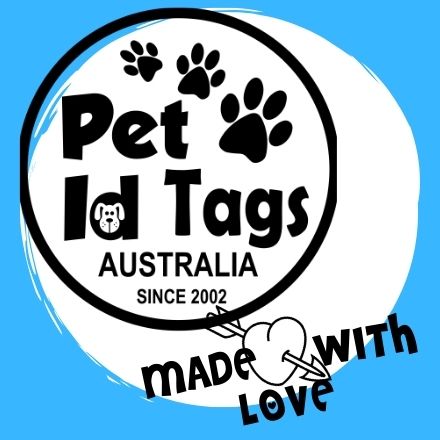According to reports, around 10 million pets disappear every year. When your dog gets lost, they are in danger. For example, an animal shelter might pick them up, and these shelters euthanize about 340,000 pets each year in the US, according to reports. That’s why your pets’ safety is crucial.
If you're a dog owner, you can imagine the heartache of disappearing your dog.
Therefore, you need a way for anyone who finds your dog to know they're not a stray: An ID tag. But the most important thing is what to put on a pet ID tag to give your dog the best chance to come back to you.
Let's find out!
What Is a Pet ID Tag?

A pet ID tag is a way for you to convey information about your pet and ensure your lost pet gets back to you safely. These tags have limited space, usually offering four lines with up to four words each.
On this tag, you need to write the information so that anyone can read it easily. Plus, you can reduce the font to fit more words.
You can do this in two ways - attaching multiple tags to your dog's collar or using a QR code. To use this code, you'll have to create a webpage listing your dog's details. Then, you'll create a QR code that links to the webpage. When someone finds your pet, they can scan the QR code and access all this information.
The Types of Pet Tags
Your dog identity tag will generally come in one of these three forms:
- Hanging Tags: They can dangle from your dog's collar. This type of tag is the most common; however, it is the most likely to catch onto branches and become damaged or lost.
- Slide-on Tags: You can slide the tag into your dog's collar. This tag is unlikely to get lost. However, you can convey information on one side of the tag. Also, you need a collar that has the space to slide in this tag.
- Rivet-on Tags: You can fix the ID onto your dog's collar. This type of tag is the least likely to get lost, but it has limited space for information since only one side is visible.
Which Material is Best for Your Pet Tags?
Typically, you should have your pet ID tags engraved in a lightweight, durable material. The tag should be large enough to engrave all necessary information and yet small enough that it doesn't catch on branches. And so you'll find that most tag materials are:
- Brass
- Plastic
- Hard Enamel
- Scratch-Proof Dome
Additionally, you can have your dog's tags plated with gold to protect them from damage.
What to Put on a Pet ID Tag

When it comes to putting an ID tag on your pet, you need to include all the legally required details. Countries have different laws, so you'll have to examine your region's requirements.
Here are the important details you should include on your pet's tag:
1. Your Name
Engraving your name on the tag is crucial so the person who finds your pet can identify you. Otherwise, a shelter or dog daycare might return your pet to the wrong person.
It's inadvisable to put your pet's name on their tag. This is because strangers can claim to be their owner or even call your pet away from you or your residence. This is especially important if your pet is a pure breed that strangers may want to steal for breeding or reselling.
2. Your Contact Information
It needs to have your contact information so whoever finds them can get in touch with you directly.
Typically, owners put their:
- Email Address: This is one of your contact details less likely to change, so it's the most reliable contact detail.
- Phone Number: If you answer calls from strangers, you can put your number on the tag. Alternatively, if you only respond to texts, you can write 'Text [number]' to ensure whoever finds your pet knows to text you instead.
- Physical Address: This is the most outdated method since it'll be easier to reach you. However, it provides additional information that could help identify your pet. This way, a neighbor who has found your dog can easily bring your pet home.
Whichever details you choose to put, ensure they're unlikely to change. If your information tends to change frequently, you can ask a loved one or a neighbor for permission to use their contact details.
3. Your Pet's Needs
You should also include details of any medication your dog needs. For example, if your dog has a diet that's out of the norm, you should also ensure there's some information on that. As this information can be too long to fit on a tag or two, you can use a QR code instead.
4. Your Pet's Illness History
If your pet has a history of illnesses or medical conditions, it is best to engrave this information into their identification tags as a QR code. The details of your pet's medical history are crucial for their safe return to you.
If your pet is susceptible to a certain disease, it is best that whoever is caring for it at the moment is aware. And they'll ensure your pet has the medication at hand or knows which symptoms to watch out for.
5. Your Pet's Vaccination Status
In some states in the US, pets must carry their rabies vaccination proof. However, even if your region has no such laws, you should still include this detail on your dog's tag.
In particular, this information can ensure whoever has your pet feels safe, helping them return to you.
6. The Pet's Neutering Status
If your pet is from a special or purebred, someone may find them and attempt to keep them for breeding purposes. And so, if you've already stated on their tag that they can't breed your pet, it could deter such people.
7. A Tag Silencer
You can use a tag silencer to reduce the noise they produce. These plastic silencers keep tags from jingling and clinking against one another or the collar.
In particular, you should get one of these if your dog doesn't like the sound. If that doesn't work, you should stitch the tag information into your dog's collar.
Recap
Knowing what to put on a pet ID tag keeps your dog safe when you're separated from them. And so they need to carry information for not only their return but also their safe custody. Therefore, you must list your current contact information, your dog's medical information, and whatever else you legally require. While this information can help your dog get back home, it's also important for your peace of mind.




